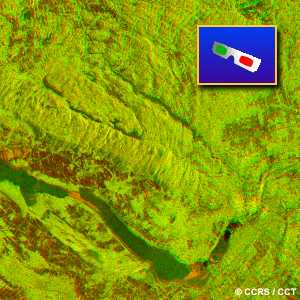Proactive disclosure
Print version   |  | 
Natural Resources Canada > Earth Sciences Sector > Priorities > Canada Centre for Remote Sensing
Anaglyphs
3.2 Anaglyphs
Anaglyphic viewing systems also rely on parallax and convergence. Here, filters of complementary colours,
usually red and blue or red and green, are used to separate left and right projections. The viewer wears a pair of
glasses which cover the left eye with green (or blue) and the right with red. The left eye sees the overlap of the
left image in green (or blue) while the right eye simultaneously sees the overlap area of the right image in red.
This produces a three dimensional perception. Although inexpensive, this method has some inherent limitations.
The source data is limited to black and white imagery. Colour imagery results in ghost effects on an anaglyphic
image. Applying red and green (or blue) filters to the original imagery causes light loss. This in turn causes some
information to be lost. The red and green glasses may also cause eye fatigue.

Anaglyph image and glasses |
|
